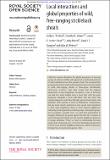Files in this item
Local interactions and global properties of wild, free-ranging stickleback shoals
Item metadata
| dc.contributor.author | Ward, Ashley | |
| dc.contributor.author | Schaerf, Timothy | |
| dc.contributor.author | Herbert-Read, James | |
| dc.contributor.author | Morrell, Lesley | |
| dc.contributor.author | Sumpter, David | |
| dc.contributor.author | Webster, Mike M. | |
| dc.date.accessioned | 2017-07-14T09:30:10Z | |
| dc.date.available | 2017-07-14T09:30:10Z | |
| dc.date.issued | 2017-07-12 | |
| dc.identifier | 250513824 | |
| dc.identifier | 290ea418-5927-489f-a019-27022f6a753f | |
| dc.identifier | 85023767234 | |
| dc.identifier | 000406670000024 | |
| dc.identifier.citation | Ward , A , Schaerf , T , Herbert-Read , J , Morrell , L , Sumpter , D & Webster , M M 2017 , ' Local interactions and global properties of wild, free-ranging stickleback shoals ' , Royal Society Open Science , vol. 4 , no. 7 , 170043 . https://doi.org/10.1098/rsos.170043 | en |
| dc.identifier.issn | 2054-5703 | |
| dc.identifier.other | ORCID: /0000-0001-9597-6871/work/60427823 | |
| dc.identifier.uri | https://hdl.handle.net/10023/11206 | |
| dc.description | Funding: Australian Research Council. A.J.W.W. and T.M.S. were supported by a Discovery Project Grant from the Australian Research Council. D.J.T.S. and J.E.H.-R. were supported by a Knut & Alice Wallenberg Foundation Grant. | en |
| dc.description.abstract | Collective motion describes the global properties of moving groups of animals and the self-organized, coordinated patterns of individual behaviour that produce them. We examined the group-level patterns and local interactions between individuals in wild, free-ranging shoals of three-spine sticklebacks, Gasterosteus aculeatus. Our data reveal that the highest frequencies of near-neighbour encounters occur at between one and two body lengths from a focal fish, with the peak frequency alongside a focal individual. Fish also show the highest alignment with these laterally placed individuals, and generally with animals in front of themselves. Furthermore, fish are more closely matched in size, speed and orientation to their near neighbours than to more distant neighbours, indicating local organization within groups. Among the group level properties reported here, we find that polarization is strongly influenced by group speed, but also the variation in speed among individuals and the nearest neighbour distances of group members. While we find no relationship between group order and group size, we do find that larger groups tend to have lower nearest neighbour distances, which in turn may be important in maintaining group order. | |
| dc.format.extent | 11 | |
| dc.format.extent | 1033993 | |
| dc.language.iso | eng | |
| dc.relation.ispartof | Royal Society Open Science | en |
| dc.subject | Collective behaviour | en |
| dc.subject | Schooling | en |
| dc.subject | Grouping | en |
| dc.subject | GE Environmental Sciences | en |
| dc.subject | QH301 Biology | en |
| dc.subject | DAS | en |
| dc.subject | BDC | en |
| dc.subject.lcc | GE | en |
| dc.subject.lcc | QH301 | en |
| dc.title | Local interactions and global properties of wild, free-ranging stickleback shoals | en |
| dc.type | Journal article | en |
| dc.contributor.institution | University of St Andrews. Centre for Biological Diversity | en |
| dc.contributor.institution | University of St Andrews. Centre for Social Learning & Cognitive Evolution | en |
| dc.contributor.institution | University of St Andrews. School of Biology | en |
| dc.identifier.doi | 10.1098/rsos.170043 | |
| dc.description.status | Peer reviewed | en |
This item appears in the following Collection(s)
Items in the St Andrews Research Repository are protected by copyright, with all rights reserved, unless otherwise indicated.

